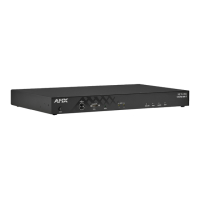NetLinx Programming
110
TPI-PRO-DVI - Instruction Manual
Run Time Operation Commands (Cont.)
SETUP Send panel to Setup page.
Syntax:
"'SETUP'"
Example:
SEND COMMAND Panel,"'SETUP'"
Sends the panel to the Setup Page.
SLEEP Force the panel into screen saver mode.
Syntax:
"'SLEEP'"
Example:
SEND COMMAND Panel,"'SLEEP'"
Forces the panel into screen saver mode.
@SOU Play a sound file.
Syntax:
"'@SOU-<sound name>'"
Variables:
sound name = Name of the sound file. Supported sound file formats are: WAV & MP3.
Example:
SEND COMMAND Panel,"'@SOU-Music.wav'"
Plays the 'Music.wav' file.
@TKP Present a telephone keypad. Pops up the keypad icon and initializes the text string to that specified. The Prompt Text is
optional.
Syntax:
"'@TKP-<initial text>;<prompt text>'"
Variables:
initial text = 1 - 50 ASCII characters.
prompt text = 1 - 50 ASCII characters.
Example:
SEND COMMAND Panel,"'@TKP-999.222.1211;Enter Phone Number'"
Pops-up the Keypad and initializes the text string '999.222.1211' with prompt text 'Enter Phone Number'.
TPAGEOFF Turn off page tracking.
Syntax:
"'TPAGEOFF'"
Example:
SEND COMMAND Panel,"'TPAGEOFF'"
Turns o ff page tracking.
TPAGEON This command turns on page tracking, whereby when the page or pop-ups change, a string is sent to the Master. This string
may be captured with a CREATE_BUFFER command for one panel and sent directly to another panel.
Syntax:
"'TPAGEON'"
Example:
SEND COMMAND Panel,"'TPAGEON'"
Turns o n page tracking.
@VKB Open the virtual keyboard.
Syntax:
"'@VKB'"
Example:
SEND COMMAND Panel,"'@VKB'"
Pops-up the virtual keyboard.
^TPO Selects which of the 2 outputs display G4 graphics.
Syntax:
SEND_COMMAND <DEV>,"'^TPO-<0-3>'"
• O = None (should not be used in a typical installation)
• 1 = G4 Graphics on output 1 only
• 2 = G4 Graphics on output 2 only
• 3 = G4 Graphics on both outputs 1 and 2 (default)
Example:
SEND_COMMAND Panel,"'^TPO-3'"
Sends G4 graphics to outputs 1 and 2.
Note: Any G4 graphics that appear over a Video Window when the ^TPO command is used to turn off G4 graphics on an
output may leave a “hole” in the video display if the button opacity is too high. The upper limit of opacity for any graphic over
a video window is panel design dependant. The more layers of graphics over a video window, the lower the opacity needs to be
set for the layers. A single layer of graphics has show that an opacity value of 250 or lower is sufficient to correct the problem.

